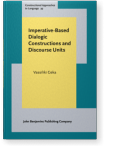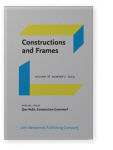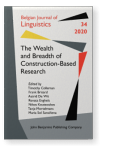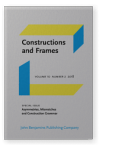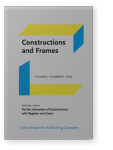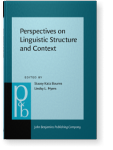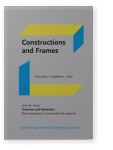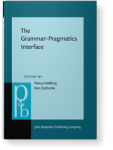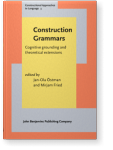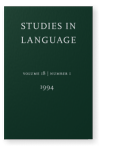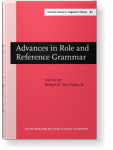Laura A. Michaelis
List of John Benjamins publications for which Laura A. Michaelis plays a role.
Book series
2024 Staying terminologically rigid, conceptually open and socially cohesive: How to make room for the next generation of construction grammarians Quo Vadis, Construction Grammar?, Boas, Hans C., Jaakko Leino and Benjamin Lyngfelt (eds.), pp. 278–310 | Article
When he introduced the framework now known as Construction Grammar, Charles Fillmore said: “Grammatical Construction Theory differs from […] other frameworks […] in its insistence that syntactic patterns are often tightly associated with interpretation instructions” (Fillmore 1989: 17).… read more
2020 Pleonastic complex words as functional amalgams The Wealth and Breadth of Construction-Based Research, Colleman, Timothy, Frank Brisard, Astrid De Wit, Renata Enghels, Nikos Koutsoukos, Tanja Mortelmans and María Sol Sansiñena (eds.), pp. 199–212 | Article
Syntactic amalgams are innovative phrasal constructions that combine otherwise incompatible subparts of other constructions (Lambrecht 1988; Brenier and Michaelis 2005). We describe pleonastic formations like flavorize in English and ψηλαφ-ίζ(ω) [psilafízo] ‘palpate’ in Modern Greek as functional… read more
2018 Match, mismatch, and envisioning transfer events: How verbal constructional bias and lexical-class concord shape motor simulation effects Asymmetries, Mismatches and Construction Grammar, Koutsoukos, Nikos, Kristel Van Goethem and Hendrik De Smet (eds.), pp. 234–268 | Article
Prior studies suggest that language users perform motoric simulations when construing action sentences and that verbs and constructions each contribute to simulation-based representation (Glenberg & Kaschak 2002; Richardson et al. 2003; Bergen et al. 2007; Bergen & Wheeler 2010). This raises the… read more
2015 What is this, sarcastic syntax? On the Interaction of Constructions with Register and Genre, Fischer, Kerstin and Kiki Nikiforidou (eds.), pp. 148–180 | Article
This study considers sarcasm as a linguistic genre, and explores the use of constructions to capture conventions of sarcastic speech. It does so by examining the English Split Interrogative (SI), e.g., What are you, a senior?, What is this, Spain? We argue that lexical, syntactic and semantic… read more
2014 Frames and the interpretation of omitted arguments in English Perspectives on Linguistic Structure and Context: Studies in honor of Knud Lambrecht, Katz Bourns, Stacey and Lindsy L. Myers (eds.), pp. 57–86 | Article
Despite the idiosyncratic properties of null-complement phenomena observed by Fillmore (1986), Lambrecht and Lemoine (2005), and others, many researchers have pursued large-scope, single-factor explanations of the distributional and interpretive restrictions on null complements – in particular,… read more
2010 A constructional account of genre-based argument omissions Grammar and interaction: New directions in constructional research, pp. 158–184 | Article
Authors like Fillmore 1986 and Goldberg 2006 have made a strong case for regarding argument omission in English as a lexical and construction-based affordance rather than one based on general semantico-pragmatic constraints. They do not, however, address the question of how grammatical… read more
2007 Lexical subjects and the conflation strategy The Grammar–Pragmatics Interface: Essays in honor of Jeanette K. Gundel, Hedberg, Nancy and Ron Zacharski (eds.), pp. 19–48 | Article
2005 Entity and event coercion in a symbolic theory of syntax Construction Grammars: Cognitive grounding and theoretical extensions, Östman, Jan-Ola and Mirjam Fried (eds.), pp. 45–88 | Chapter
1994 A Case of Constructional Polysemy in Latin Studies in Language 18:1, pp. 45–70 | Article
In this paper, I will examine the syntactic and semantic properties of a Latin correlative construction, the so-called comparative conditional. I will investigate the extent to which this construction inherits its formal and interpretive features from constructions needed independently in the… read more
1992 On deviant case-marking in Latin Advances in Role and Reference Grammar, Van Valin Jr., Robert D. (ed.), pp. 311–374 | Article
